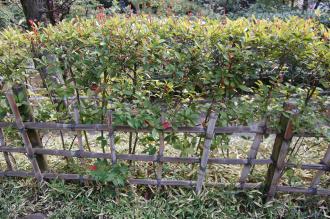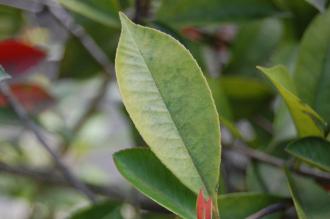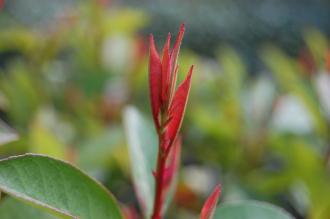
Photinia glabra Hedge (01/04/2015, Tokyo, Japan)
Position: Full sun to partial shade
Soil: Moist, well drained
Flowering period: Spring
Eventual Height: 5m
Eventual Spread: 4m
Hardiness: 7a, 7b, 8a, 8b, 9a, 9b, 10a, 10b
Family: Rosaceae
Photinia glabra is an evergreen shrub with a compact upright habit. Its mid green leathery leaves are elliptic with entire margins, up to 9cm long and 4cm broad. Its leaves emerge bright red in spring. Its small white flowers in corymb-like panicles which are up to 12cm across. Its red berry like fruit are ovoid and are up to 5mm across.

Photinia glabra Leaf (01/04/2015, Tokyo, Japan)
Photinia glabra, commonly known as Japanese Photinia, Red Leaf Photinia, is native to Japan and south east China. In its native habitat it grows in mixed forests. It should be noted that all members of the Photinia genus are highly poisonous to grazing animals should not be planted in any situation where they might encounter it.
The etymological root of the binomial name Photinia is derived from the Greek photeinos meaning ‘shining’ in reference to its glossy leaves. Glabra is from the Latin meaning ‘hairless’.
The landscape architect may find Photinia glabra useful as as an effective hedging species which provides spring interest. The new growth may be damaged by a late frosts so a sheltered position is advised.
Ecologically, Photinia glabra flowers are attractive to pollinating insects with its nectar and the larvae of some species of Lepidoptera feed on its leaves.

Photinia glabra New Leaf (01/04/2015, Tokyo, Japan)
Photinia glabra prefers moist, fertile, well-drained soils. It will tolerate most pH of soil, and will tolerate very alkali soils.
Photinia glabra requires little maintenance. If grown as a hedge it should be cut when the new growth has lost its color. This plant can be trimmed up to three times a year to encourage new red growth, although pruning is not advised after mid August.

